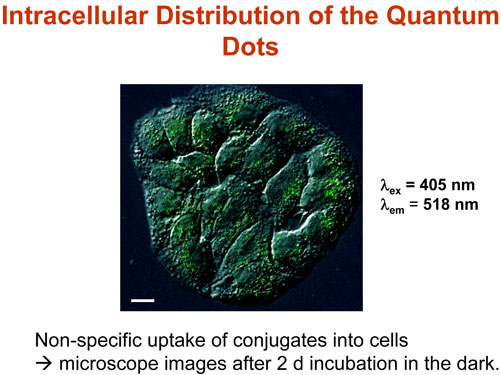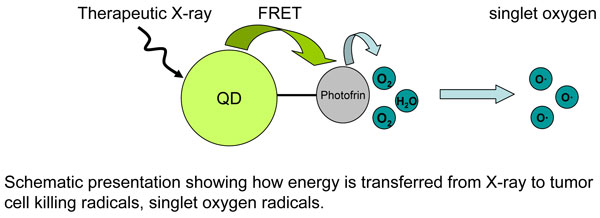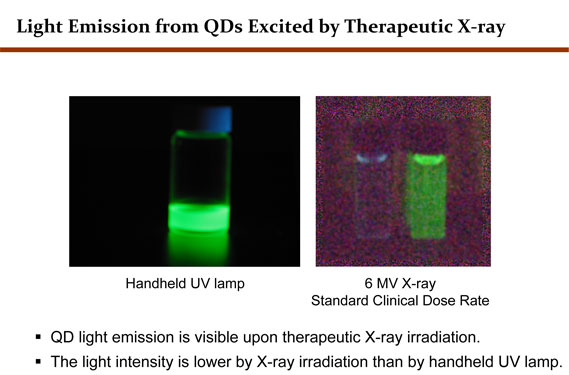News Release
NEWS RELEASE: NANOPARTICLES + LIGHT = DEAD TUMOR CELLS
Novel Cancer Therapy Described at 50th AAPM Meeting in Houston, July 29
A NOVEL WAY TO KILL TUMOR CELLS USING NANOPARTICLES AND LIGHT
July 29, 2008 -- Medical physicists at the University of Virginia have created a novel way to kill tumor cells using nanoparticles and light. The technique, devised by Wensha Yang, an instructor in radiation oncology at the University of Virginia, and colleagues Ke Sheng, Paul W. Read, James M. Larner, and Brian P. Helmke, employs quantum dots. Quantum dots are semiconductor nanostructures, 25 billionths of a meter in diameter, which can confine electrons in three dimensions and emit light when exposed to ultraviolet radiation.

Yang and her colleagues realized that quantum dots also give off light when exposed to megavoltage x-rays, such as those used in cancer radiotherapy. That property, the scientists realized, makes quantum dots an ideal mediator in therapies employing light-activated compounds to treat cancer.

A compound called Photofrin is the only photosensitizer currently approved by the FDA. Photofrin is absorbed by cancer cells and, upon exposure to light, becomes active and kills cells. It is currently used to treat certain kinds of shallowly located tumors, but Yang and her colleagues realized that combing Photofrin with quantum dots could create an efficient method to kill even deeply seated cancer cells. Upon exposure to high doses of radiation, the dots become luminescent and emit light; that light triggers the cancer-killing activity of the Photofrin. In theory, the process, which so far has been studied only in cancer cells grown in culture, could work on tumors located too deep within the body to be reached by an external light source

To prevent normal tissues from being affected by the treatment, the toxicity of the quantum dot-Photofrin conjugate is only activated when radiation is applied. Also, the area to be treated is targeted with conformal radiation, which is delivered with high precision within the three-dimensional contours of the tumor, with minimal spillover to surrounding healthy tissues. As a result, Yang says, "the toxicity of the drug is substantially lower in the lower radiation dose area" outside the boundaries of the tumor. In tests on human lung carcinoma cells, the process resulted in a 2-6 times lower tumor cell survival compared to radiation alone, but with minimal toxicity to nearby cells.
Yang will describe the technique in her talk, "Enhanced Energy Transfer From Mega-Voltage Radiation to the Tumor Cell Killing Singlet Oxygen by Semiconductive Nanoparticles," on Tuesday, July 29, during the 50th annual meeting of the American Association of Physicists in Medicine (AAPM), the largest medical physics association in the world. The meeting takes place from July 27 to July 31, in Houston, Texas.
****************************************************************RELATED LINKS
- AAPM home page: http://www.aapm.org
- Abstracts and search form: http://www.aapm.org/meetings/08AM/MeetingProgram.asp
- Press Guide: http://www.aapm.org/meetings/08AM/VirtualPressRoom/
- Background article about how medical physics has revolutionized medicine:
http://www.newswise.com/articles/view/538208/
HOW TO COVER THE MEETING
Reporters who would like to attend the meeting in person should fill out the press registration form on the AAPM Virtual Press Room. See: http://www.aapm.org/meetings/08AM/VirtualPressRoom/documents/pressregform.pdf.
Reporters who would like to cover the conference remotely will find releases and articles on the Virtual Press Room highlighting many of the interesting and important talks presented at the meeting. Even if you can't make it to Houston, the Virtual Press Room will make it possible to write stories about the meeting from your desk.
ABOUT AAPM
The American Association of Physicists in Medicine (AAPM) is a scientific, educational, and professional nonprofit organization whose mission is to advance the application of physics to the diagnosis and treatment of human disease. The association encourages innovative research and development, helps disseminate scientific and technical information, fosters the education and professional development of medical physicists, and promotes the highest quality medical services for patients. In 2008, AAPM will celebrate its 50th year of serving patients, physicians, and physicists. Please visit the association's Web site at http://www.aapm.org/.
ABOUT AIP
Headquartered in College Park, MD., the American Institute of Physics is a not-for-profit membership corporation chartered in New York State in 1931 for the purpose of promoting the advancement and diffusion of the knowledge of physics and its application to human welfare.
####
Media contacts:
Jason Socrates Bardi, American Institute of Physics,
301-209-3091 (office) 858-775-4080 (cell)
jbardi@aip.org
Jeff Limmer, AAPM Media Relations Subcommittee Chair
jeffl@aspirus.org
